| Roodstad | |
|---|---|
| Historical facts | |
| Alternate names | City of Brick, Red City |
| Founded | 1439 |
| Patron Saint | St. Robbe |
| Information | |
| Parish | Helmond |
| Population | 80,805 |
| Mayor | Willem Vaarnise (CDU) |
| Postal code | 5000, 5001, 5002 |
Roodstad (English: Red City) is a city located on Central Island, the largest island of Brunant. The city is the largest city (but not the capital) of Helmond Parish, a parish located on the western coast of Central Island. Roodstad itself is located at a natural harbor on the south coast of the Bay of Robbe. The bay is found south of the Cape Cross area, which forms a clear border with the Roodstad's region of Helmond. The current population of the city is 80,000 and growing (making it the fifth largest city in the nation), and the mayor is Willem Vaarnise, who took office in 2006. The city is one of the oldest in Brunant, founded in 1439, and continuously inhabited since then. Today, it is a quickly growing economic powerhouse in the country, with a focus on shipping, manufacturing, and (traditionally) fishing.
History[]
Early history[]
Roodstad was founded 1439 by Dutch settlers. Due to its strategic location on the Bay of Robbe and the passing by of trade routes from North Africa and Europe, the new village quickly began to grow and develop, reaching a population of one thousand by 1478. The Red River was tamed and even today still flows through the town uncovered. A fortress and defense system (known to the present day as the Red Castle) was soon built and completed in 1489 to protect the town from invaders (and indirectly help slow any attacks headed towards Grijzestad) that might attempt to take it. Due to the large clay deposits in the bay and beaches, brick became the normal building material, which partially led to the name of the city. The large forests surrounding Roodstad were also largely cut down to provide wood and lumber.
The farming community around the town, established a decade before the city was founded, had also grown larger in order to feed the town. The main crops are grains, such as wheat and rye, along with sizable orchards. In addition to providing supplies for the non-farmers living into the city, the farmers helped to build the Church of Saint Robbe in 1461 (completed in 1509) and other buildings, which attracting even more settlers to Roodstad. Great fisheries, employing nearly as many people as the commercial and subsistence farmers, also developed, becoming a signature aspect of the city, remaining to this day.
Development[]
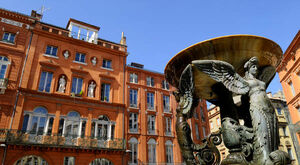
The Historic District of Roodstad.
By the dawn of the sixteenth century, Roodstad had transformed from a tiny farming community to one of the largest cities in Brunant.
During the Civil War, which pitted royalist supporters of King Willem II in 1663 against rebel supporters of Karl Van Draak. Roodstad at first took sides with the royalists, and combined forces with an allied city, Nieuw Helmond, located several miles south of the city, and successfully defended Nieuw Helmond from rebel forces. Although the war never came to Roodstad, the government of the city agreed to an ultimatum from the rebels after the Battle of Brunant (which sealed the loss of the royalist forces), and submitted to the rebel government. This was seen by the citizens of Roodstad as dishonorable, but little unrest occurred.
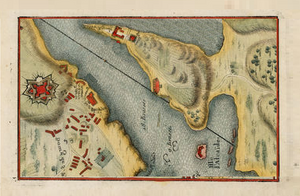
Roodstad port, 1755
Despite avoiding the destruction of the Civil War, Roodstad was not spared by the French during the Franco-Brunanter War. The city was initially spared from the fighting, but following the Siege of Grijzestad the town's port became the main base for the Realmarine, thus a major target for the French. In April 1758, the Libertan navy engaged the Brunanter navy in the largest naval battle of the war. In 1758, following an aggressive French campaign against the Brunanters, the Siege of Roodstad began. Like other towns, such as Donderstad and Carrington, the defenders were unable to hold out. The French breached the castle walls and began to enter the city. Roodstad quickly surrendered on June 11. By the time the French secured the city, two hundred had been killed, although the French also suffered sizable losses. Reinforcements from Grijzestad and Koningstad would soon liberate the town from the retreating French forces in October, after only four months of occupation. The government of Roodstad was reestablished, and men from Roodstad quickly joined the march towards Donderstad, the last town under French control, which would be liberated on January 3, 1759.
Roodstad's economy began to boom in the 19th century, with the shipping industry quickly growing, and factories being constructed. Roodstad even began to become known as "The Hub of Brunant", due to the city's massive influence in Brunant's economy. Shipbuilding also began, with many ships of the Realmarine being built in the factories and drydocks along the coast. The number of ships built was second only to Grijzestad. Due to the heavy pollution coming from the industrialized city, the fishing industry began to collapse from lack of healthy fish. This eventually lead to some action to reduce the water pollution that went into the bay.
The city build and established its own university in 1801 to attract some students to Brunant and promote education in the city, as a significant part of the population lacked higher education. This university was highly successful, and today is known as Roodstad College.
The World Wars[]
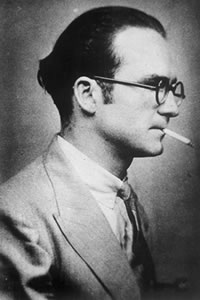
Maarten Dolmatoff, who was overwhelmingly supported in Roodstad.
Coming into the 20th century, Roodstad, Koningstad, and Grijzestad were all prospering as the economic centers of Brunant. With new strong city walls and a strong front on technological innovation, Roodstad was as powerful as it could ever seem to be. The population was soaring, and industry was booming. The recovery of the fishing industry and increased trade between Europe and North Africa added to the city's monetary value.
As Brunant was neutral during World War I, Roodstad, along with the rest of Brunant, became a safe haven for refugees and deserters. Many of these immigrants stayed, and a growing working class in the city was established, eventually leading to the creation of several grocers, diners, and apartments that popped up to suit the new residents. Perhaps the most famous restaurant in the city is the Meijer Diner, famous worldwide for its breakfast waffles and pancakes.
During the interbellum period, the city was known for the strong pro-leftist forces within it. It was a stronghold of the Communist Party and the Social Democratic Party, voting overwhelmingly for the communist Maarten Dolmatoff (who eventually won) in the 1928 Presidential Elections. Since then, it has supported the SDP or the Socialist Left Party in every election.
During World War II, when Brunant was invaded by Nazi Germany, Roodstad put up resistance instead of surrendering. Resistance was rather stiff, but German field guns pounded the city and reduced much of it to rubble. German soldiers entered the city and secured the land on May 25, 1941. They quickly stamped out any resistance, despite some light casualties. The relatively high Jewish population was largely able to successfully avoid being found by the Nazis, though those that were found were shot. When news came that liberation was imminent and a fight could be heard outside the city, the people of Roodstad rose up and began to revolt against the occupiers. This significantly sped up the liberation of the city. Few German occupiers survived.
Modern history[]
Damaged by the war, Brunant and Roodstad exited World War II badly shaken up. By the 1960s, the city had become very run down. However, renovation efforts soon began, during Mayor Pierpont's administration (1956-1972). These renovated several landmarks, such as the Vaaldrecht Bridge over the Red River and Statue of Fraternity, were restored, and new city parks and sidewalks were added. Investments into sanitation were increased, and by 1980 Roodstad was looking beautiful again. The city walls were also beautified and decorated, which soon became a signature tourist attraction of the city.
In the 1960s, the Roodstad Underground (often simply called the Under) was ordered to be constructed to make transportation easier in the now bustling city. The new subway system links the sectors of Roodstad together, and is connected to a fast above-ground train service to Donderstad, Nieuw Helmond, Koningstad, Boguestown, and Cape Cross. Later, in the 1980s, extensions to system were created in the city suburbs. In the outer areas, the train is above ground. Regardless, the train system is still known as "the Under" within the city.
In 2006, Roodstad was struck by two twin terrorist bombings, attributed to the Barzona Libre movement. This resulted in the destruction of two Roodstad Underground stations, the deaths of 11 people (most due to a collapsing ceiling), and injuries of 37. A memorial in the town square was completed in 2009. Security has since increased in Roodstad and revisions have been made to the rail system.
Geography[]
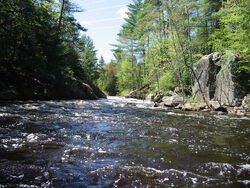
The Red River, several miles from its outlet.
Roodstad is built at the mouth of the Red River (second only to the Martiges River in length), which empties into a natural harbor, which is in turn an inlet of the Bay of Robbe, located in Western Central Island. The area where Roodstad is built is relatively flat, with some very gentle hills. The land is quite fertile and close to sea level, which allows for plenty of farming to occur in the former forests outside the city, which are now meadows and farms. After traveling inland for several kilometers, the land quickly becomes rockier, eventually becoming mountainous. Peaks can be seen in the distance if looking east from Roodstad.
Climate[]
Roodstad has Mediterranean climate with slightly higher than usual humidity, due to the mountains located to the west forcing clouds to drop extra moisture on the coastal settlement. The average temperature is 21°C. Because the ocean mediates the atmospheric heat, the daytime temperature usually does not drop below 4°C or go above 28°C. The record high temperature is 37°C (recorded July 24, 1980 (during the 1980 Brunanter heat wave)), and the record low is -5°C (recorded January 7, 1951).
Politics[]
The May 2018 election saw the Socialist Left Party finish first, but a strong showing from the CDU and FLP created a stalemate in government formation. Eventually in early August A Better Brunant backed an FLP government, which the CDU further supported.
| Party | Seats | |
| SLP | 5 / 19 | |
| CDU | 4 / 19 | |
| FLP | 3 / 19 | |
| ABB | 3 / 19 | |
| SD | 2 / 19 | |
| ECO | 1 / 19 | |
| P70 | 1 / 19 | |
Economy[]
Roodstad's prosperous economy is based upon agriculture, fishing, shipping, manufacturing, and shipbuilding, and the city has a very diverse economy.
Agriculture[]
Farms have been providing food for Roodstad since the city's founding. The main crops are grains, primarily wheat, though there are several fruit orchards and vegetable farms as well. Wine production is also high in Roodstad's parish, and several wineries and grape farms can be found outside the city walls. Most of the farms are small family farms, and animal farming is relatively low when compared to other parishes.
Fishing[]
Fishing is very common in Roodstad, and has been a component of the economy since the 15th century. Various types of fish and shellfish are caught in the Bay of Robbe. Things that are caught are mainly sold at the Daaneson Market, a famous fish market in the city. Today, the market also sells other products, such as artisan goods and agricultural products, but fish and shellfish remain a major item.
Shipping[]
Roodstad has been one of the largest trading hubs in Brunant since the 19th century. Due to the city's position close to a strait, where ships often pass through, it has prospered greatly, and became a large trade city. The growth of manufacturing in Roodstad also has helped the shipping. Most of the shipping is done by sea, though there is land shipping is usually done by train to other areas of Brunant. The major things exported out out of Roodstad are manufactured goods and food.
Manufacturing[]
Manufacturing was originally a minor industry in Brunant, but after the immigration surge of World War II, big companies found that the city would make an excellent place to build factories and provide jobs, especially with the Red River nearby and inexpensive labour being available. By the 1920s, several hundred were being employed in factories to make a wide variety of products; while consumer goods were the main products (such as Instant), other items like cars (ALTAs and now Volkswagens) are also made in Roodstad. The products are then sent by boat or train to other parts of the world. The large factory labour led to the growth of several labour unions in Roodstad, and the strong support of the Social Democratic Party and the Socialist Left Party in the city.
Shipbuilding[]
Roodstad has only recently, since the 1880s, began to be a centre of shipbuilding. Many submarines and warships were built in the city, owing to the steel factories that have helped to provide the raw materials to make the ships. Today, approximately 40% of the ships of the Realmarine have been constructed in the drydocks of Roodstad, along with many private ships.
Businesses[]
Businesses in Roodstad include: Maxi, Ipermarket.
Culture[]
Roodstad has a very well defined culture. Some of the most famous events in the city include the Mardi Gras celebration, which is the largest in the nation, the Independence Day parade, and the Christmas celebrations during the holidays. In addition to these, the Daaneson Market, a fish market, is located in the city, which is very famous as one of the most well known fish markets in the country.
Sports[]
Roodstad's most popular sport, like most other cities in Brunant, is association football. The city has a single football team competing in the Second League, Roodstad Athletic. RAFC has only been in the First League for seven years, in three different periods, but it is often in the top half of the 2. Liga's standings. The team has won the 2. Liga four times, the most recent being in 2000. For the 2012-13 season, RAFC recruited star U-20 defender Adrian Lecaros-Lerner, and the team is hoping to win the 2. Liga and be promoted to the 1. Liga.
Other popular sports in Roodstad are handball, cycling and korfball. Roodstad's team has won the Brunanter national handball championship many times, with its main competitor being Sint-Anders. One of the most famous cyclists from Brunant, Anders Meersk, was born and raised in Roodstad. An korfball-club named De Roden, is located in the town and is playing in the Second Division.
Roodstad RLFC, a rugby league club that competes in the Brunanter Rugby League is also based in the city. In recent years, rugby league has become very popular in Roodstad.
Schools[]
The schools in Roodstad are Havering Primary School and Gerd Duithers College. Sint Robbe School is a mixed private school run by the CAE Institute.
Tourism[]
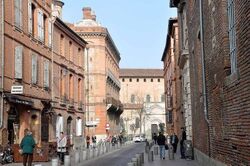
Street in the old town
While tourism in Roodstad is significantly less frequent than in other cities such as Grijzestad or Cape Cross, there are several attractions within in the city, as there are many historic buildings, monuments, and areas to visit.
Attractions[]
- Quincentennial Park - A four block park constructed in 1938 and opened in 1939 to honor the five hundredth anniversary of the city's founding.
- Historic District - The oldest region of Roodstad, with buildings dating back to the 17th century and earlier. Includes several museums, including the Roodstad Museum of Art.
- Daaneson Market - An old fish market dating to the 15th century, including several famous places to eat and non-seafood shops in addition to the famous fish and shellfish.
- Vaaldrecht Bridge - A bridge crossing the Red River. The structure has had a very intriguing history, as it has been ruined and repaired in the past.
- Statue of Fraternity - Famous statue lying in the inside of a roundabout. It was built in the 18th century and originally located elsewhere, but was moved to the roundabout in 1880.
- Red Castle - The fort that once defended the city, but is now a museum. It was built in the 15th century.
- Cathedral of Saint Robbe - The main cathedral in Roodstad, dating back to the 18th century, and completed in the 20th century.
Events[]
- Roodstad Mardi Gras - The largest Mardi Gras celebration in Brunant.
- The Independence Day parade, which has been going on since 1918.
- The Christmas celebrations, including the well known ice sculptures and many other aspects.
Map[]
See the page Map colors for an explanation of what each color means.
| Bay of Robbe Mediterranean Sea | |||||||||
| Beach | |||||||||
| Red Castle 1 Robbe Street |
Red Street | ||||||||
|---|---|---|---|---|---|---|---|---|---|
| *1 | FOR SALE 2 Robbe Street |
Look 1 J. Brandis Street |
*2 | Alchimie 2 J. Brandis Street |
FOR SALE 1 D. Pierpoint Street |
*3 | The Screwdriver 2 D. Pierpoint Street | ||
| Noordstraat | |||||||||
| FOR SALE 4 Robbe Street |
Roodstad Museum of Art 3 J. Brandis Street |
Roodstad Stadium Roodstad RLFC 4 J. Brandis Street |
Daaneson Market 3 D. Pierpoint Street |
Santander Stadium Home of Roodstad Athletic 4 D. Pierpoint Street | |||||
| FOR SALE 3 Robbe Street |
FOR SALE 6 Robbe Street |
Gerd Duithers College 5 J. Brandis Street |
Quincentennial Park 6 J. Brandis Street |
FOR SALE 6 D. Pierpoint Street | |||||
| Fenix 5 Robbe Street |
FOR SALE 8 Robbe Street |
De Arien Roodstad 7 J. Brandis Street |
Instant 8 D. Pierpoint Street | ||||||
| Zuidstraat | |||||||||
| Havering Primary School 2 Zuidstraat |
FOR SALE 4 Zuidstraat |
St. Robbe Square | Cathedral of Saint Robbe 6 Zuidstraat |
Meijer Diner 8 Zuidstraat |
FOR SALE 10 Zuidstraat | ||||
| Roodstad War Cemetery 7 Robbe Street |
FOR SALE 10 Robbe Street |
Sint-Francis 9 J. Brandis Street |
Sint-Francis Hospital Centre 8 J. Brandis Street |
Ipermarket 5 D. Pierpoint Street |
Sint Robbe School 10 D. Pierpoint Street | ||||
- *1 - Robbe Street
- *2 - Juan Brandis Street
- *3 - Douglas Pierpont Street
Notable Roodstaders[]
- Juan Brandis, writer and poet
- Douglas Pierpont, mayor and Underground Revolution member
- Ines van Donck, fashion designer
